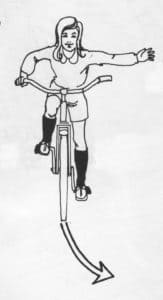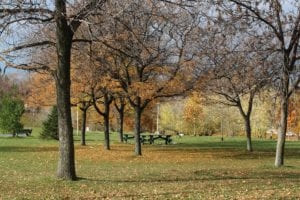Kelsey Saunders is a building scientist with SUSTAINABLE.TO, a collaborative architecture firm that specializes in sustainability. Her role is to help model designs to make sure they perform well in areas of health and energy efficiency, including energy modelling, hygrothermal analysis, and sustainable design consulting. She also provides technical support and helps in research and development into new and existing technologies for residential construction.
Saunders has a Bachelor of Architectural Science from Ryerson University and is concurrently working towards her Master’s of Applied Science in Building Science. In the interview below, Women’s Post learns more about building science, what it means to truly build sustainably, and what needs to change in the industry.
Q: What drew you to architecture as a career?
A: I was always fascinated by architecture and the ability of space to evoke emotion and change perception, even before understanding how or why these spaces could be so moving. I wasn’t one of those people who always knew what they wanted to do and so I didn’t necessarily think that I would become an architect, but I had this special connection with architecture. My initial understanding was that architecture was mostly about aesthetics, because this is often how its portrayed, but when I came to understand that it is mostly about function I was hooked with the concept of shaping how people flow through and use the built environment and the impact it has on everyday life.
Why specialize in building science?
I’ve always done well in math and science, and in fact started out my academic career at the University of Guelph majoring in chemistry and taking calculus and physics courses. I enjoyed the work, but I didn’t see a career path, so I changed lanes and decided to pursue my passion for architecture. I did my undergrad at Ryerson University in the Bachelor of Architectural Science program. In fourth year, students specialize in either Architecture (design), Project Management, or Building Science. In the first three years I did really well in building science courses and found them to be the most meaningful and practical. At this time I still thought I would pursue a career in architecture, but wanted to get a deeper understanding of building science principles to improve my ability to design good buildings.
What exactly is a building scientist?
Building Science is a relatively new discipline that is filling a much needed gap between architecture and engineering (although many building scientists traditionally were engineers, until more recently). Building science is the analysis and control of the physical elements that affect buildings, such as climate, air movement, heat transfer, water, and moisture. Basically, it’s the science behind how we keep buildings dry and warm. The role of building science is to optimize the performance of buildings for improved energy efficiency, durability, indoor air quality, and comfort. There are many roles a building scientist can play. At SUSTAINABLE.TO Architecture + Building we do things differently. “Sustainability” is ingrained in the service we offer. It is not an additional service. Building science is integrated directly into the architectural design process to create durable, healthy, energy-efficient buildings for our clients. I’ve been with SUSTAINABLE.TO for nearly four years now. For me, it’s the dream job because my love of architecture and my science-based brain get to play together on a daily basis. We provide energy-modelling during concept design to guide our design decisions, air-tightness testing during construction as quality-assurance. It’s important to us that our buildings perform as well in practice as we intend them to.
Your focus at the moment is on sustainable building – what new developments are out there that our readers should be aware of?
Something that we are trying to focus on more at our office these days is embodied energy, which is the energy consumed by all of the processes associated with the production of a product, from the time it is mined to when it is installed on the job site. Previously, much of the focus has been placed on how much energy we can save by building an efficient building. So, for example, foam insulation products with high embodied energy have been used extensively to insulate new and existing building to reduce their energy consumption. What we are not realizing is that often, the energy saved over the life of the building doesn’t even cover the energy embodied in that foam insulation. So, if thats the case, what was the point? This is something that needs to be considered when designing truly sustainable buildings. There are some incredible natural building materials (even new innovative ones) with very low embodied energy – straw, clay plaster, cellulose, etc. – that we would love to see become mainstream. They are also safer and healthier choices.
Sometimes people can be overwhelmed when it comes to introducing sustainable options into their home – is there one thing you would suggest everyone doing in order to make a real difference?
The most important “sustainable strategy” is a good building envelope – which is the outside shell of your home, including all exterior walls, roof(s), and basement walls/floor. Investing in a good building envelope will reduce operating costs by improving energy efficiency, comfort, and the overall durability of your home. The best way to achieve this is to insulate, air-seal, and address water in the form of vapour and liquid. If you’re looking to renovate in the near future, insulation and air-tightness can be successfully address in a few different ways depending on how your home is built and the scope of your renovation. As a start, having a blower-door test performed on your home to detect potential air leaks and sealing them up with caulking and/or tape would help. You’d be shocked at the difference this will make to your energy bills. In terms of addressing water, make sure all of your downspouts and roof eaves are clean and directing water away from your home.
How well are Toronto builders doing in terms of sustainability? What more needs to be done?
Honestly, there are a handful of builders in Toronto that are leading the charge in terms of sustainable building. Sadly, it has been the same group of builders for the last 10 years and not much has changed. We attribute this to two things. First, the common “I’ve been building this way for years” mentality. Habits are hard to change, people are strong willed, and they don’t want to hear that they’ve been doing it wrong. Second, building codes are slow to change. As an example, we have been specifying continuous exterior insulation for years, and each year we push how much exterior insulation we use even further and as a result we push our contractors to develop methods of building better buildings. By contrast, the Ontario Building Code only now requires minimal exterior insulation as of 2017, and even then there are options to comply to the energy code without it – by installing more efficient mechanical equipment! It just seems crazy, but its a direct result of push-back from the building industry who thinks that exterior insulation is impossible.
What are you currently working on within Sustainable TO?
As the resident Building Scientist at an architecture firm, I typically get involved in every project in some way. The simplest way I find to describe my role is that I provide technical support to our design team. On some projects, this might be as simple as an intra-office consultation about the best way to insulate and air-seal a building, which windows to select, review mechanical drawings from an HVAC designer, etc. On other projects, I will take on a larger role including energy modelling for building performance optimization, specification of building materials, building envelope detailing (drawings details of how the building should be constructed for optimum efficiency/durability), field reviews during construction, and blower door testing. We also offer these services to projects from clients who have an architect but need a sustainability consultant to optimize energy performance, health, and durability. This can also include consulting and certification for programs like LEED and Passive House.
You are finishing (or are you finished) your Master’s of Applied Science at Ryerson – what are your goals for afterward?
I am completing my Master of Building Science at Ryerson, to graduate in Spring 2018. I’ve been doing it part-time while working at SUSTAINABLE.TO over the past 4 years. Honestly, I don’t see much changing for me one I receive it. I already have the job I want with a company and a team that I am proud to be a part of. As SUSTAINABLE.TO grows, I would like to simultaneously grow the building science department (currently just myself) and broaden the scope of our services.
What do you do when you aren’t working and what are you reading right now?
When I’m not working, I’m typically spending time with my black lab/boxer Odin. I’m very active and love to be outdoors. I’ve recently gained a love and respect for high-intensity training at the gym and supplementing with yoga. I’m a big foodie and have embraced vegetarianism by experimenting with new and interesting foods. I love to travel, but who doesn’t!
I’m currently reading a book called “The Little Book of Hygge: The Danish Way to Live Well” written by Meik Wiking, a researcher at the Happiness Research Institute in Copenhagen. Its about living a balanced life full of Hygge (translated loosely into “coziness” in a Canadian context). It’s an easy ready, but between work and school it’s a perfect read right now.
Did you enjoy this profile? If so, sign up for our weekly e-newsletter and we will send them to you via carrier pigeon to your inbox!



